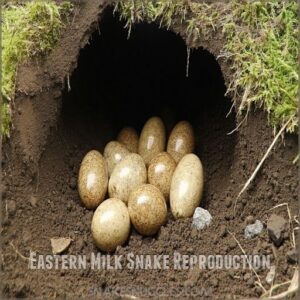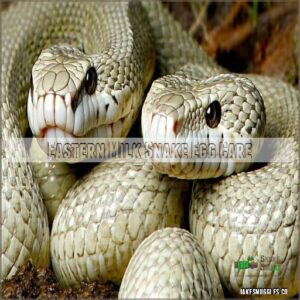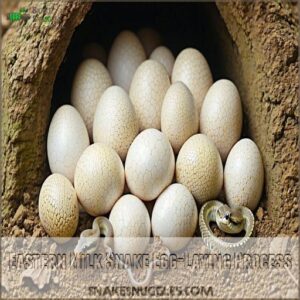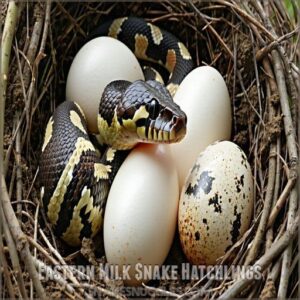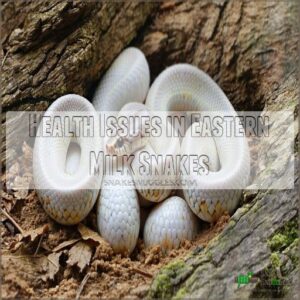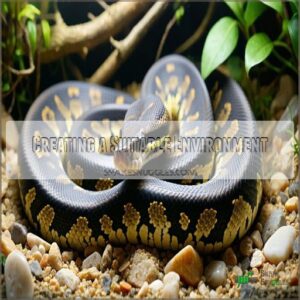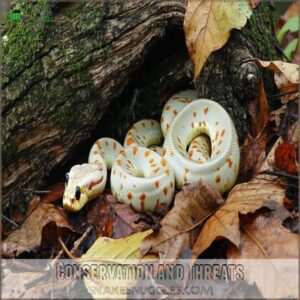This site is supported by our readers. We may earn a commission, at no cost to you, if you purchase through links.
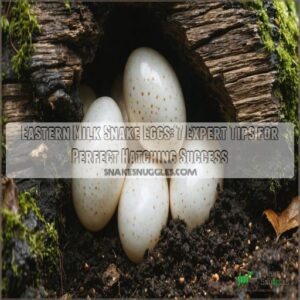 You’ll find eastern milk snake eggs in underground burrows or rotting logs, where mother snakes lay clutches of 4-25 elongated white eggs each spring.
You’ll find eastern milk snake eggs in underground burrows or rotting logs, where mother snakes lay clutches of 4-25 elongated white eggs each spring.
These leathery-shelled eggs measure 1-1.5 inches long and need specific conditions to thrive: temperatures between 82-85°F and humidity levels of 80-85%.
You’ll know they’re fertile if candling reveals distinctive veining and a pinkish glow.
After 6-8 weeks of careful incubation, your patience pays off as tiny 7-10 inch hatchlings emerge, ready to hunt on their own.
Mastering the art of egg care involves some surprising techniques that even seasoned herpers don’t know about.
Table Of Contents
- Key Takeaways
- What Are Eastern Milk Snake Eggs
- Eastern Milk Snake Reproduction
- Eastern Milk Snake Egg Care
- Top 3 Products for Eastern Milk Snake Care
- Eastern Milk Snake Egg-Laying Process
- Eastern Milk Snake Hatchlings
- Health Issues in Eastern Milk Snakes
- Creating a Suitable Environment
- Handling and Safety
- Conservation and Threats
- Frequently Asked Questions (FAQs)
- How many eggs does an eastern milk snake lay?
- What do eastern milk snakes eat?
- What is an eastern milk snake?
- How long do eastern milk snakes live?
- When do milk snakes lay their eggs?
- Are eastern milk snakes good pets?
- How long does it take for milk snake eggs to hatch?
- How many eggs do Eastern milk snakes lay?
- Can I feed my milk snake eggs?
- What do you need to know about milk snakes?
- Conclusion
Key Takeaways
- You’ll find eastern milk snakes laying 4–25 white, leathery eggs, measuring 1–1.5 inches, in underground burrows during late spring or early summer.
- You’ll need to maintain temperatures between 82–85°F and humidity levels of 80–85% during the 6–8 week incubation period for successful hatching.
- You can identify fertile eggs through candling, which reveals distinctive veining and a pinkish glow, while avoiding rotating them once positioned.
- You’ll see 7–10 inch hatchlings emerge, ready to hunt independently, requiring a proper habitat with temperatures between 75–89°F and humidity levels of 65–75%.
What Are Eastern Milk Snake Eggs
You’ll find eastern milk snake eggs in underground burrows or crevices.
Females lay 4-25 elongated, white eggs measuring about 1-1.5 inches long.
The eggs have a soft, leathery texture that helps protect the developing snakes during their 6-8 week incubation period.
Identification
Spotting eastern milk snake eggs can be tricky, but once you know what to look for, you’ll become a pro at identification.
These eggs have distinctive shell markings that set them apart from other snake species.
You’ll typically find them in clutches of 4-25 eggs, with telltale characteristics like a leathery texture and off-white coloration. When candling, fertile eggs show clear veining and a pinkish glow. Distinctive shell markings and a pinkish glow are key identifiers.
Shape
Eastern milk snake eggs showcase a distinctive elongated form that sets them apart from other reptile eggs. You’ll notice these eggs come in an oval shape, much like tiny footballs.
Here’s what makes their shape special:
- Each egg measures roughly twice as long as it’s wide
- The ends taper gently, creating smooth curves
- The middle section maintains uniform width
- Individual eggs within a clutch share similar shapes
- Slight variations in symmetry are normal and healthy
Texture
The leathery texture of milk snake eggs sets them apart from rigid bird eggs.
Let’s explore why this unique characteristic matters for successful breeding: The coloration of Eastern Milk Snake eggs, featuring red blotches bordered with black against a white or yellow background, serves the dual purpose of camouflage and potential mimicry of toxic coral snake patterns.
| Texture Feature | Significance |
|---|---|
| Soft, pliable shell | Prevents cracking during laying |
| Leather-like surface | Allows oxygen exchange |
| Smooth exterior | Protects developing embryo |
| Slightly sticky when fresh | Keeps clutch together |
| Flexible membrane | Accommodates growing embryo |
You’ll notice these eggs feel like soft leather when gently touched, though it’s best to minimize handling to promote successful hatching.
Size
When measuring your eastern milk snake eggs, you’ll find they’re perfectly sized for successful incubation. These leathery treasures typically measure between 1 and 1.5 inches in length, with a diameter of 0.5 to 0.8 inches.
- Just right for cradling in your palm
- Small enough to fit several in an incubator
- Large enough to house a healthy hatchling
The size often indicates fertility – properly sized eggs have better hatching rates.
Color
Most eastern milk snake eggs display a pure white to off-white coloration, though you’ll occasionally spot subtle variations.
Here’s what you need to know about egg coloring:
| Color Stage | Description | Significance |
|---|---|---|
| Fresh Laid | Pure white, glossy | Healthy, viable egg |
| Mid-incubation | Off-white, matte | Normal development |
| Pre-hatching | Translucent, pinkish | Imminent hatching |
You’ll notice the shells gradually becoming more translucent as hatching approaches, letting you monitor development.
Eastern Milk Snake Reproduction
You’ll find that eastern milk snakes lay 4-25 leathery eggs in underground burrows during late spring or early summer, with each egg measuring about an inch long.
After a 6-8 week incubation period, you’ll watch as tiny hunters emerge, already equipped with the skills to catch their own prey, and become tiny hunters.
Mating and Breeding
Springtime signals nature’s call for eastern milk snakes to begin their intricate courtship dance.
You’ll notice males tracking females through chemical trails, leading to gentle intertwining rituals that can last several hours.
During breeding season, successful mating depends heavily on maintaining good temperatures between 75-85°F.
Experienced breeders often separate males from females outside breeding season to prevent stress and guarantee reproductive success.
Egg Laying
Female eastern milk snakes lay their eggs in carefully chosen spots between late May and early July.
Their clutches, typically 4-25 eggs, are tucked away in underground burrows, rotting logs, or warm compost piles.
Each egg measures about 1-1.5 inches long and has a distinctive leathery, white shell.
For those looking to replicate these conditions, a reptile egg incubator can be a valuable tool.
The mother guarantees proper placement in areas with ideal moisture and temperature conditions.
Incubation Period
After your milk snake lays eggs, you’ll need to maintain precise incubation conditions for 6-8 weeks. Think of it as running a tiny nursery where every detail counts.
Since milk snakes typically lay eggs once a year, though a second clutch is possible depending on environmental factors like milk snake breeding seasons, it’s essential to get incubation right.
Here’s what makes incubation successful:
- Keep temperatures steady between 80-85°F
- Monitor humidity levels at 80-90%
- Check eggs daily for discoloration or mold
- Avoid rotating eggs once they’re positioned
A slight wobble in these conditions can affect your hatchling success rate, so stay vigilant.
Eastern Milk Snake Egg Care
You’ll need precise temperature control and consistent humidity levels to successfully incubate your eastern milk snake eggs during their 6-8 week development period.
Your careful attention to maintaining these conditions will help guarantee healthy hatchlings emerge from their soft, leathery shells.
Incubating Snake Eggs
Setting up a proper incubation space for your Eastern milk snake eggs starts with selecting the right container.
A plastic container with small ventilation holes works perfectly.
Line it with moistened vermiculite or perlite substrate, creating small dimples to cradle each egg.
Place the eggs exactly as you found them – flipping them can harm the developing embryos.
Keep the container in a quiet, stable location away from direct light.
Temperature and Humidity
Maintaining the perfect balance for your milk snake eggs is like being a weather controller.
Keep the temperature steady at 82-85°F using a reliable thermostat and heating pad.
You’ll want humidity levels between 80-85% – think tropical rainforest conditions. Mist the substrate lightly when needed, but don’t let water pool.
A digital hygrometer is your best friend for accurate readings.
Hatching Process
The delicate dance of hatching begins when your Eastern milk snake eggs start dimpling and sweating – nature’s signal that new life is ready to emerge.
You’ll notice tiny slits appearing as hatchlings use their egg tooth to break free.
During this 24-48 hour process, maintain stable conditions and resist the urge to help – they’ve got this!
Once fully emerged, these independent hunters are ready for their first meal.
Top 3 Products for Eastern Milk Snake Care
You’ll want to invest in three essential products to give your eastern milk snake eggs the best chance of successful hatching.
A reliable heating pad, digital thermometer with humidity gauge, and UVB lamp will help you maintain the precise environmental conditions these delicate eggs need.
1. VIVOSUN Reptile Heating Pad with Thermostat
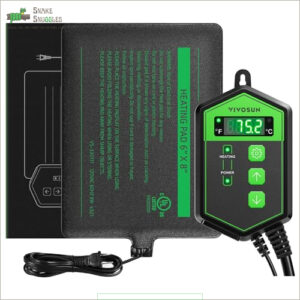
A reliable heating pad sits at the heart of successful egg incubation.
The VIVOSUN Reptile Heating Pad combines far-infrared heating technology with UL-certified materials to create a consistent environment your eggs need.
Its digital thermostat maintains temperatures between 40-108°F, perfect for milk snake eggs.
While the 3M adhesive mounting might need reinforcement for heavier setups, the IP67 water-tight surface and double insulation offer peace of mind.
Just remember to check the thermostat regularly, as some users report occasional malfunctions after extended use.
Best For: Reptile breeders needing a reliable, affordable heating pad for incubating eggs or maintaining a consistent temperature for smaller reptiles.
- Durable, UL-certified materials and IP67 water-tight surface.
- Digital thermostat for precise temperature control (40-108°F).
- Far-infrared heating technology for even heat distribution.
- Some users report thermostat failure after a month of use.
- Adhesive may not be strong enough for all applications or heavier enclosures.
- Relatively small heat mat; may not be suitable for all reptiles or large enclosures.
2. Zoo Med Digital Thermometer Humidity Gauge

While monitoring your Eastern milk snake’s environment remains critical, you’ll find the Zoo Med Digital Thermometer Humidity Gauge a reliable companion.
This compact device features a waterproof probe and easy-to-read digital display that tracks both temperature and humidity levels.
You’ll appreciate its versatility with a single LR44 battery that lasts surprisingly long.
Though the suction cup might need reinforcement, you can easily solve this with a bit of tape.
Just keep in mind the display can be tricky to read at angles, but its accuracy makes up for this minor drawback.
Best For: Reptile keepers who need an affordable and accurate way to monitor temperature and humidity.
- Accurate temperature and humidity readings.
- Compact and easy to move around.
- Long battery life.
- Suction cup may not hold well.
- Display can be difficult to read at an angle.
- Sensor and head unit may be damaged in transit.
3. Zoo Med Reptisun 50 Mini UVB Lamp
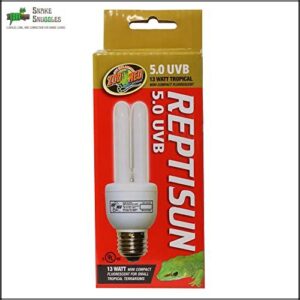
Investing in the Zoo Med Reptisun 5.0 UVB Mini Compact Fluorescent can up your snake’s enclosure game, especially when paired with a suitable substrate like Zoo Med Reptisoil, which maintains moderate humidity levels.
At just 13 watts, this compact powerhouse creates the perfect UVB zones your eastern milk snake needs.
You’ll love its versatility – mount it vertically or horizontally using the special UVB-transmitting quartz glass. Replace it every 6-12 months for best performance, and always buy from reputable sources to avoid counterfeits.
Pro tip: Use reflective domes to maximize UVB distribution and consider your enclosure’s mesh top. Zoo Med Reptisun 5.0 UVB and UVB zones.
Best For: Reptile owners seeking a compact, efficient UVB solution for smaller enclosures, particularly those housing tropical species like milk snakes.
- Versatile mounting options (vertical or horizontal) with special UVB-transmitting quartz glass
- Energy-efficient 13-watt design that doesn’t produce excessive heat
- Strong track record of reliability and consistent performance from a reputable manufacturer
- Needs replacement every 6-12 months for optimal performance
- Limited coverage area compared to linear UVB bulbs
- Mesh tops and enclosure barriers can significantly reduce UVB effectiveness
Eastern Milk Snake Egg-Laying Process
You’ll find your eastern milk snake laying 4-25 white, leathery eggs in underground burrows during late spring or early summer.
The eggs will measure between 1-1.5 inches long.
They need a consistent temperature for 6-8 weeks until they hatch.
The eggs hatch into independent 7-10 inch babies.
When Do Milk Snakes Lay Their Eggs
After setting up proper heating equipment, you’ll want to monitor your female milk snake’s reproductive cycle.
Eastern milk snakes typically lay eggs in late spring or early summer, usually between May and July.
As seen in the milk snake breeding cycle, environmental cues like temperature changes and increased daylight trigger egg-laying behavior.
A healthy female can produce 4-25 eggs per clutch, with the entire laying process taking several hours to complete.
Where Do Snakes Lay Their Eggs
Eastern milk snakes dig deep into their chosen nesting spots to lay eggs in secure locations.
You can find specialized products for creating snake egg laying sites online. For example, you can find them on websites that offer snake egg laying supplies.
You’ll typically find their eggs in these prime spots:
- Underground burrows with loose, moist soil
- Hidden crevices between rocks or fallen logs
- Protected areas under leaf litter or mulch
- Abandoned rodent tunnels or natural cavities
These locations provide the perfect mix of temperature, humidity, and protection that developing eggs need to thrive.
How Many Eggs Can a Snake Lay
A milk snake‘s clutch size ranges from 4 to 25 eggs, with several factors influencing the final count.
Here’s a quick breakdown of what affects egg production:
| Factor | Impact on Clutch Size |
|---|---|
| Age | Older females lay more |
| Size | Larger snakes = bigger clutches |
| Health | Better condition = more eggs |
| Diet | Well-fed = increased fertility |
| Environment | Ideal conditions boost numbers |
Your snake’s first clutch might be smaller, but don’t worry – that’s completely normal.
Eastern Milk Snake Hatchlings
You’ll find your newly hatched eastern milk snake measuring between 7 to 10 inches long.
Your baby snake won’t need feeding assistance since it’s already absorbed its yolk sac before breaking through its shell.
It’s ready to hunt independently from day one, making it a self-sufficient hunter from the start.
Baby Snake Care
Now that your eggs have successfully hatched, your baby milk snakes need specialized care.
These tiny serpents measure 7-10 inches at birth and come equipped with hunting instincts. You’ll want to handle them gently and infrequently in their first weeks.
Provide multiple hiding spots in their enclosure and maintain proper humidity levels between 40-60%. Keep their space clean with daily spot checks.
Diet and Feeding
Your baby milk snake‘s appetite might surprise you – these tiny hunters come ready to chase their first meal.
For more information on their natural diet, check out what milk snakes typically eat in the wild what do milk snakes eat.
Start with pinkie mice every 5-7 days, making sure the prey isn’t wider than your snake’s body.
Keep fresh water available 24/7, and don’t forget calcium supplements dusted on their food once a week.
Watch them strike with precision – it’s like they’re born knowing exactly what to do!
Growth and Development
After mastering their feeding routine, watch these fascinating creatures transform.
Baby milk snakes grow rapidly, increasing from 7-10 inches at birth to 2-4 feet as adults. Most reach adult size within 2-3 years.
They’ll shed every 4-6 weeks during their growth spurts, with each molt revealing brighter colors. Track their progress by measuring shed skins – it’s like having a growth chart for your scaly friend.
Health Issues in Eastern Milk Snakes
You’ll need to watch for common health issues in your eastern milk snake, including parasites, respiratory infections, and weight problems.
To guarantee your pet stays healthy and active.
While these snakes are generally hardy, catching potential health problems early can make the difference between a quick recovery and a serious illness that affects breeding success.
Parasites and Diseases
Throughout their lives, Eastern Milk Snakes can face several health challenges, particularly parasites and fungal infections.
Watch for external parasites like mites (tiny black dots) or internal parasites that cause weight loss and lethargy.
If you suspect a mite infestation, consider purchasing products for snake mite treatment to effectively manage the issue.
Snake fungal disease is a serious concern, appearing as crusty scales or discolored patches.
Regular health checks, proper humidity, and maintaining a clean enclosure are your best defense against these issues.
Respiratory Infections
Respiratory infections in eastern milk snakes can knock the wind out of your breeding plans.
Once parasites compromise their immune system, snakes become vulnerable to respiratory issues, showing symptoms like wheezing and nasal discharge.
- Monitor breathing patterns – look for open-mouth breathing or unusual sounds
- Check for mucus around nostrils and mouth
- Listen for clicking sounds during respiration
- Watch for loss of appetite or lethargy
Keep humidity levels balanced and maintain proper temperature gradients to prevent these infections from taking hold.
Obesity and Poor Nutrition
Poor feeding habits lead to obesity in eastern milk snakes, much like any pet.
Here’s what you need to know about keeping your snake healthy:
| Risk Factor | Symptoms | Prevention |
|---|---|---|
| Overfeeding | Visible fat rolls | Feed every 10-14 days |
| Large prey | Sluggish movement | Prey size = snake’s girth |
| Lack of exercise | Difficulty moving | Provide climbing spots |
| Wrong temperature | Poor digestion | Maintain 75-89°F gradient |
Pay attention to these signs to make sure your snake stays fit and active.
Creating a Suitable Environment
You’ll need to create an environment that perfectly mimics an eastern milk snake’s natural nesting conditions, with the right mix of temperature, lighting, and humidity levels working together.
Your success in hatching healthy snake eggs depends on maintaining stable conditions.
in a properly sized enclosure with appropriate substrate, much like creating a five-star hotel for your serpentine guests.
Enclosure and Substrate
Before setting up your eastern milk snake’s enclosure, you’ll need a 20-30 gallon tank with proper ventilation.
Line the bottom with 2-3 inches of safe substrate like newspaper or wood chips (avoid cedar and pine).
Place at least two snake hides – one on each end – and add branches, rocks, or cork bark for enrichment. Spot clean daily and replace substrate monthly to maintain a healthy environment. Eastern milk snake enclosure setup.
Temperature and Lighting
Your Eastern milk snake needs a carefully managed temperature gradient between 75°F (cool side) and 89°F (basking area). Set up your heat lamp on one end of the enclosure to create this range.
A thermostat-controlled heating pad underneath the tank provides reliable ambient warmth.
While UVB lighting isn’t essential, maintaining a consistent 12/12 hour light/dark cycle helps regulate their natural behaviors.
Humidity and Water Quality
Getting humidity right works hand-in-hand with temperature control. Keep levels between 65-75% using a quality hygrometer, and mist the enclosure 2-3 times weekly.
For water, provide a shallow dish large enough for your snake to soak in, but not so deep it risks drowning.
Watch for signs of dehydration like wrinkled skin or stuck shed, and adjust misting frequency accordingly. Clean and refresh water daily. Humidity control and water requirements are crucial for snake health.
Handling and Safety
You’ll need to use extra care when handling eastern milk snake eggs, as their soft, leathery shells are sensitive to temperature changes and physical pressure.
While these non-venomous snakes are generally docile,
you’ll want to maintain proper safety measures during egg handling to protect both yourself and the developing embryos.
Milk Snake Behavior and Temperament
Understanding milk snake behavior reveals the secrets to successful breeding.
These docile reptiles prefer flight over fight, though they’ll put on quite a show when feeling threatened. Like skilled actors, they’ll mimic rattlesnakes by vibrating their tails against dry leaves.
While mostly active during daylight hours, they’ll switch to nighttime hunting when temperatures soar.
Their social structure? They’re the ultimate loners, preferring a solitary lifestyle.
Handling Techniques and Precautions
Proper handling techniques keep both you and your eastern milk snake calm and content.
Start by supporting the snake’s entire body, never grabbing the tail or head.
Move slowly and deliberately, using a hook if needed to guide the snake.
Let your snake rest for 48 hours after feeding before handling.
If they show signs of stress, like rapid tongue flicking, give them space.
Safety Measures and Precautions
The key to safe milk snake handling lies in understanding their behavior and respecting their space. When working with these creatures, remember they’re more afraid of you than you’re of them.
- Always wash your hands before and after handling to prevent disease transmission
- Keep a steady grip without squeezing too tightly
- Support the snake’s entire body length
- Never handle them during shedding or after feeding
Wear thin gloves if you’re nervous, but they’re not necessary since milk snakes rarely bite.
Conservation and Threats
You’ll need to understand the threats facing eastern milk snakes if you want to help protect these beneficial creatures and their eggs in the wild.
While these adaptable snakes face challenges from habitat loss and climate change, you can make a difference by supporting local conservation efforts and helping to educate others about their important role in controlling rodent populations.
eastern milk snakes and their important role
Habitat Loss and Fragmentation
Today, eastern milk snakes face mounting challenges as their natural habitats shrink and fragment. These changes substantially impact their breeding success and survival rates.
Here’s a detailed look at how habitat disruption affects these remarkable creatures:
| Impact Area | Urban Areas | Suburban Areas | Rural Areas | Mountain Areas |
|---|---|---|---|---|
| Severity | Severe | Moderate | Low | Minimal |
| Recovery | Unlikely | Possible | Likely | Natural |
| Timeline | 10+ years | 5-10 years | 2-5 years | 1-2 years |
| Status | Critical | Concerning | Stable | Protected |
Conservation efforts now focus on creating wildlife corridors to reconnect fragmented populations.
Human Persecution and Misunderstanding
Widespread misconceptions about eastern milk snakes continue to fuel needless persecution. Despite their gentle nature, these beneficial creatures often face fear-based killing due to mistaken identity with venomous species.
Here’s what you should know about common misconceptions:
- They’re often mistaken for copperheads
- People wrongly believe they drink cow’s milk
- Some think they’re aggressive predators
- Many assume all snakes are venomous
Educating communities about these harmless snake species helps protect local populations and maintains healthy ecosystems.
Climate Change and Disease
Climate shifts pose growing challenges for eastern milk snakes, with warming temperatures disrupting their natural egg-laying cycles.
Rising temperatures also force snakes to seek new habitats, making them more vulnerable to infections. You’ll notice these changes affecting both wild and captive populations through increased disease susceptibility, particularly to snake fungal disease.
To protect your breeding pairs, monitor temperature fluctuations carefully and maintain strict hygiene protocols.
Frequently Asked Questions (FAQs)
How many eggs does an eastern milk snake lay?
Eastern milk snakes typically lay between 4 and 25 eggs during late spring or early summer.
You’ll find these leathery, white eggs carefully hidden in underground burrows, where they’ll incubate for 6-8 weeks.
What do eastern milk snakes eat?
Adult milk snakes can consume prey up to their body width.
They eat small mammals, birds, eggs, lizards, and amphibians.
Babies prefer insects and small invertebrates for their growing needs.
What is an eastern milk snake?
You’ll find this non-venomous snake sporting distinctive reddish-brown splotches with black borders on a light background.
It’s a docile creature that can grow 2-4 feet long.
It typically lives 12-20 years.
How long do eastern milk snakes live?
With proper care and attention, your milk snake can be a fascinating companion for 12-20 years in captivity.
These resilient reptiles thrive when provided with appropriate habitat, nutrition, and regular veterinary checkups.
When do milk snakes lay their eggs?
After patiently waiting through winter, milk snakes lay their eggs in late spring or early summer.
They’ll deposit 4-25 white, leathery eggs in underground burrows.
where they’ll incubate for 6-8 weeks.
Are eastern milk snakes good pets?
Eastern milk snakes make excellent pets due to their docile nature, manageable size, and easy care requirements.
They’re non-venomous.
They are generally friendly and can live 12-20 years with proper care and handling.
How long does it take for milk snake eggs to hatch?
Like a patient gardener waiting for spring blooms, you’ll need to wait 6-8 weeks for your milk snake eggs to hatch.
During this time, the eggs incubate safely in underground burrows or crevices.
How many eggs do Eastern milk snakes lay?
You’ll find a female milk snake laying between 4 to 25 eggs during late spring or early summer.
The typical clutch size is around 10 eggs.
They’re placed in underground burrows for protection.
Can I feed my milk snake eggs?
While milk snakes eat eggs in the wild, it’s best to feed your pet frozen-thawed mice instead.
They provide better nutrition and are easier to digest.
Young snakes need feeding every 5 days, adults every
What do you need to know about milk snakes?
Milk snakes are docile, non-venomous pets reaching 2-4 feet long. They need a 20-30 gallon enclosure with proper heating (75-89°F), eat rodents, and live 12-20 years with proper care.
Conclusion
Mastering eastern milk snake eggs isn’t rocket science, but it does require attention to detail.
You’ve now got the essential knowledge to create the perfect environment for successful breeding and hatching.
Consistent temperatures, proper humidity levels, and minimal handling are your keys to success.
Whether you’re a first-time breeder or an experienced herpetoculturist, these expert tips will help guarantee your eastern milk snake eggs develop into healthy, vibrant hatchlings.
Keep learning, stay patient, and enjoy the rewarding journey of snake breeding.


